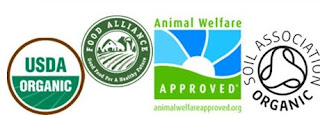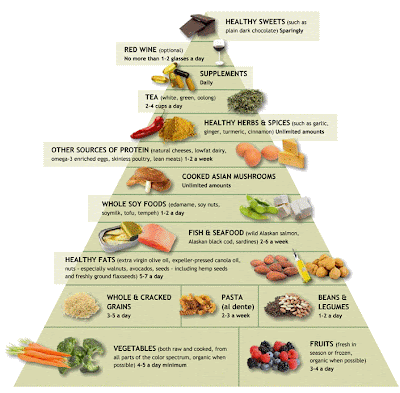"Let food by thy medicine, and medicine be thy food." - Hippocrates
Today we're constantly hearing about how chronic inflammation is harmful to us. But what does that really mean?
Inflammation is our body's reaction to stress or injury. That is a good thing when we cut our finger or get sick. The body mounts a defense to protect us against infection and let healing begin. While our body can effectively deal with smalls amount or intermittent levels of stress, this same mechanism can cause the body to turn on itself when a constant barrage of anxiety and stress causes us to become chronically inflamed. Add to that a poor diet and lack of exercise and many medical professionals believe the build-up of this inflammation promotes aging and according to a 2004 article in
Time Magazine, "may be the engine that drives many of the most feared illnesses of middle and old age." The negative effects of chronic inflammation have been linked to Alzheimer's disease, cancer, diabetes, and heart disease.
This "Silent Killer" makes eating an anti-inflammatory diet even more important than ever to our health. What do we eat to cool the fires of inflammation?
Here is a great resource from
Dr. Weil, a doctor of integrative medicine. He has created the following
anti-inflammatory food pyramid.
Here is a link to the printable version. I'm also including a summary of the pyramid below with the specific guidelines.
HEALTHY SWEETS
How much: Sparingly
Healthy choices: Unsweetened dried fruit, dark chocolate, fruit sorbet
Why: Dark chocolate provides polyphenols with antioxidant activity. Choose dark chocolate with at least 70 percent pure cocoa and have an ounce a few times a week. Fruit sorbet is a better option than other frozen desserts.
RED WINE
How much: Optional, no more than 1-2 glasses per day
Healthy choices: Organic red wine
Why: Red wine has beneficial antioxidant activity. Limit intake to no more than 1-2 servings per day. If you do not drink alcohol, do not start.
TEA
How much: 2-4 cups per day
Healthy choices: White, green, oolong teas
Why: Tea is rich in catechins, antioxidant compounds that reduce inflammation. Purchase high-quality tea and learn how to correctly brew it for maximum taste and health benefits.
HEALTHY HERBS & SPICES
How much: Unlimited amounts
Healthy choices: Turmeric, curry powder (which contains turmeric), ginger and garlic (dried and fresh), chili peppers, basil, cinnamon, rosemary, thyme
Why: Use these herbs and spices generously to season foods. Turmeric and ginger are powerful, natural anti-inflammatory agents.
OTHER SOURCES OF PROTEIN
How much: 1-2 servings a week (one portion is equal to 1 ounce of cheese, 1 eight-ounce serving of dairy, 1 egg, 3 ounces cooked poultry or skinless meat)
Healthy choices: Natural cheeses, lowfat yogurt, omega-3 enriched eggs, skinless poultry, grass-fed lean meats
Why: In general, try to reduce consumption of animal foods. If you eat chicken, choose organic, cage-free chicken and remove the skin and associated fat. Use organic, reduced-fat dairy products moderately, especially yogurt and natural cheeses such as Emmental (Swiss), Jarlsberg and true Parmesan. If you eat eggs, choose omega-3 enriched eggs (made by feeding hens a flax-meal-enriched diet), or organic eggs from free-range chickens.
COOKED ASIAN MUSHROOMS
How much: Unlimited amounts
Healthy choices: Shiitake, enokidake, maitake, oyster mushrooms (and wild mushrooms if available)
Why: These mushrooms contain compounds that enhance immune function. Never eat mushrooms raw, and minimize consumption of common commercial button mushrooms (including crimini and portobello).
WHOLE SOY FOODS
How much: 1-2 servings per day (one serving is equal to ½ cup tofu or tempeh, 1 cup soymilk, ½ cup cooked edamame, 1 ounce of soynuts)
Healthy choices: Tofu, tempeh, edamame, soy nuts, soymilk
Why: Soy foods contain isoflavones that have antioxidant activity and are protective against cancer. Choose whole soy foods over fractionated foods like isolated soy protein powders and imitation meats made with soy isolate.
FISH & SEAFOOD
How much: 2-6 servings per week (one serving is equal to 4 ounces of fish or seafood)
Healthy choices: Wild Alaskan salmon (especially sockeye), herring, sardines, and black cod (sablefish)
Why: These fish are rich in omega-3 fats, which are strongly anti-inflammatory. If you choose not to eat fish, take a molecularly distilled fish oil supplement, 2-3 grams per day.
HEALTHY FATS
How much: 5-7 servings per day (one serving is equal to 1 teaspoon of oil, 2 walnuts, 1 tablespoon of flaxseed, 1 ounce of avocado)
Healthy choices: For cooking, use extra virgin olive oil and expeller-pressed organic canola oil. Other sources of healthy fats include nuts (especially walnuts), avocados, and seeds - including hemp seeds and freshly ground flaxseed. Omega-3 fats are also found in cold water fish, omega-3 enriched eggs, and whole soy foods. High-oleic sunflower or safflower oils may also be used, as well as walnut and hazelnut oils in salads and dark roasted sesame oil as a flavoring for soups and stir-fries
Why: Healthy fats are those rich in either monounsaturated or omega-3 fats. Extra-virgin olive oil is rich in polyphenols with antioxidant activity and canola oil contains a small fraction of omega-3 fatty acids.
WHOLE & CRACKED GRAINS
How much: 3-5 servings a day (one serving is equal to about ½ cup cooked grains)
Healthy choices: Brown rice, basmati rice, wild rice, buckwheat, groats, barley, quinoa, steel-cut oats
Why: Whole grains digest slowly, reducing frequency of spikes in blood sugar that promote inflammation. "Whole grains" means grains that are intact or in a few large pieces, not whole wheat bread or other products made from flour.
PASTA (al dente)How much: 2-3 servings per week (one serving is equal to about ½ cup cooked pasta)
Healthy choices: Organic pasta, rice noodles, bean thread noodles, and part whole wheat and buckwheat noodles like Japanese udon and soba
Why: Pasta cooked al dente (when it has "tooth" to it) has a lower glycemic index than fully-cooked pasta. Low-glycemic-load carbohydrates should be the bulk of your carbohydrate intake to help minimize spikes in blood glucose levels.
BEANS & LEGUMES
How much: 1-2 servings per day (one serving is equal to ½ cup cooked beans or legumes)
Healthy choices: Beans like Anasazi, adzuki and black, as well as chickpeas, black-eyed peas and lentils
Why: Beans are rich in folic acid, magnesium, potassium and soluble fiber. They are a low-glycemic-load food. Eat them well-cooked either whole or pureed into spreads like hummus.
VEGETABLES
How much: 4-5 servings per day minimum (one serving is equal to 2 cups salad greens, ½ cup vegetables cooked, raw or juiced)
Healthy Choices: Lightly cooked dark leafy greens (spinach, collard greens, kale, Swiss chard), cruciferous vegetables (broccoli, cabbage, Brussels sprouts, kale, bok choy and cauliflower), carrots, beets, onions, peas, squashes, sea vegetables and washed raw salad greens
Why: Vegetables are rich in flavonoids and carotenoids with both antioxidant and anti-inflammatory activity. Go for a wide range of colors, eat them both raw and cooked, and choose organic when possible.
FRUITS
How much: 3-4 servings per day (one serving is equal to 1 medium size piece of fruit, ½ cup chopped fruit, ¼ cup of dried fruit)
Healthy choices: Raspberries, blueberries, strawberries, peaches, nectarines, oranges, pink grapefruit, red grapes, plums, pomegranates, blackberries, cherries, apples, and pears - all lower in glycemic load than most tropical fruits
Why: Fruits are rich in flavonoids and carotenoids with both antioxidant and anti-inflammatory activity. Go for a wide range of colors, choose fruit that is fresh in season or frozen, and buy organic when possible.
WATER
How much: Throughout the day
Healthy choices: Use purified water or beverages made with purified water, such as unsweetened tea, sparkling water, or water with a small amount of fruit juice for flavor
Why: Water is vital for overall functioning of the body.



